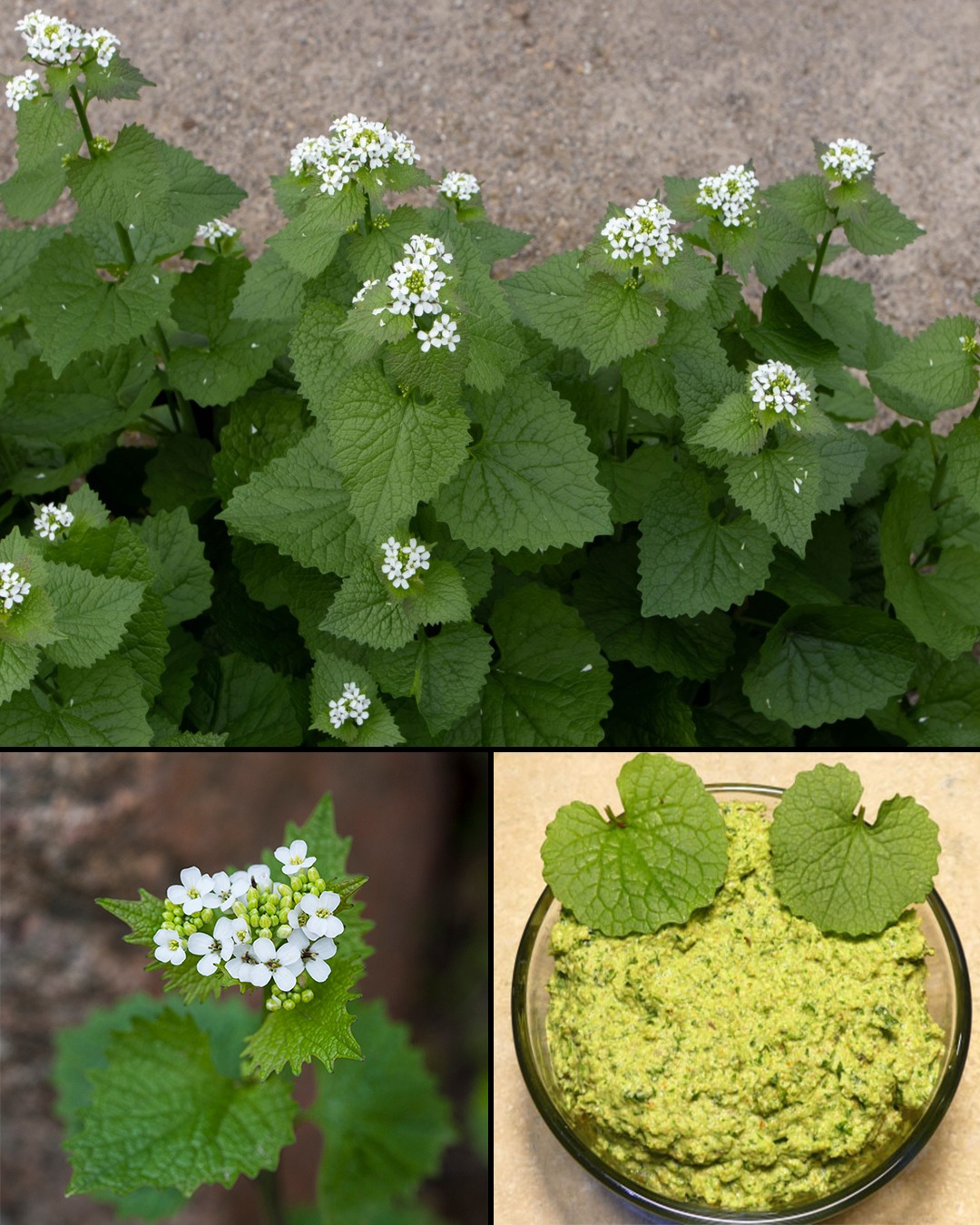Garlic mustard (Alliaria petiolata), despite its name, is not a herb or vegetable typically used in cooking or herbal medicine. Instead, it is a notorious invasive plant species that has posed ecological challenges in various parts of the world. This article provides a detailed overview of garlic mustard, including its characteristics, distribution, ecological impact, management, and potential uses.
Characteristics of Garlic Mustard
- Taxonomy: Garlic mustard belongs to the Brassicaceae family, making it a relative of many well-known plants like cabbage, broccoli, and mustard. Its scientific name is Alliaria petiolata.
- Appearance: Garlic mustard is a biennial or sometimes short-lived perennial herb. In its first year, it forms a basal rosette of kidney-shaped, coarsely toothed leaves. In the second year, it produces a tall flowering stem that can reach up to 3 feet in height. The leaves, when crushed, emit a strong garlic or onion-like odor, hence the name “garlic mustard.”
- Flowers: The small, white, four-petaled flowers of garlic mustard form in clusters at the top of the stem in late spring. They can be a key identifying feature, but they are often overlooked due to their small size.
- Seeds: Garlic mustard produces elongated, slender seed pods, called siliques. Each silique contains numerous small, black seeds that are easily spread by wind, water, animals, or human activity.
Distribution
Garlic mustard is native to Europe and parts of Asia but has become invasive in various regions around the world. Its invasive distribution includes:
- North America: Garlic mustard was introduced to North America in the 19th century, and it has become a significant invasive species in the United States and Canada.
- United Kingdom: Garlic mustard is also considered invasive in the UK, where it poses a threat to native woodlands and hedgerows.
- New Zealand: In New Zealand, garlic mustard is recognized as an invasive plant that threatens native biodiversity.
- Other Locations: It has also been reported as invasive in parts of Australia and some other regions.
Ecological Impact
Garlic mustard’s invasive nature and ecological impact are of concern due to the following reasons:
- Competition with Native Plants: Garlic mustard outcompetes native plant species for resources, particularly light, water, and nutrients. This can lead to a decline in native plant populations.
- Altering Ecosystem Dynamics: The presence of garlic mustard can alter the structure and function of local ecosystems, potentially reducing biodiversity and disrupting food webs.
- Chemical Defense Mechanisms: Garlic mustard produces allelopathic compounds that inhibit the growth of other plants, potentially giving it a competitive advantage in its invaded habitats.
Management of Garlic Mustard
Efforts to manage garlic mustard typically involve a combination of strategies, including:
- Mechanical Control: This can include hand-pulling, mowing, or cutting garlic mustard plants before they produce seeds.
- Chemical Control: Herbicides may be used to target garlic mustard in larger infestations, but this approach requires careful application to avoid harm to non-target plants.
- Biological Control: Some regions have introduced natural enemies of garlic mustard, such as specific insects and fungi, to help control its spread.
- Prevention: Preventing the introduction of garlic mustard to new areas is essential. This can involve education and awareness campaigns, as well as adhering to regulations on the movement of plants and seeds.
Potential Uses
Despite being primarily recognized as an invasive plant that requires management and control, garlic mustard (Alliaria petiolata) has garnered some attention for its potential uses in culinary and traditional herbal medicine. Below, we delve into greater detail about these potential uses:
Culinary Use
Some individuals with an adventurous palate have explored the culinary potential of garlic mustard. Here are some specifics on its culinary use:
- Flavor Profile: Garlic mustard’s leaves, when crushed or bruised, emit a distinct garlicky or onion-like aroma, which is its most notable culinary attribute. This flavor profile has piqued the interest of foragers and chefs.
- Edible Parts: The young, tender leaves of garlic mustard are the primary edible part of the plant. These leaves are typically harvested in the spring when they are still relatively mild and not overly bitter.
- Salads: Garlic mustard leaves are often used in salads, where they can add a subtle garlic-like flavor. They can be combined with other salad greens to create unique and flavorful salads.
- Seasoning: In addition to salads, some culinary enthusiasts have experimented with using garlic mustard leaves as a seasoning in various dishes. The leaves can be finely chopped and used as a garnish or incorporated into recipes as a mild garlic substitute.
- Pesto: Garlic mustard leaves can also be used as an ingredient in pesto, blended with other traditional components like basil, garlic, pine nuts, Parmesan cheese, and olive oil.
Important Considerations for Culinary Use
It is crucial to approach the culinary use of garlic mustard with caution and responsibility:
- Sustainable Harvesting: Harvesting garlic mustard for culinary purposes should be done sustainably to avoid contributing to the spread of the invasive population. Foragers and chefs should be aware of local regulations and guidelines for responsible harvesting.
- Positive Identification: Accurate identification is essential to avoid mistaking garlic mustard for other, potentially toxic, plants. There are look-alike plants in the wild, so proper identification skills are vital.
- Local Regulations: In some regions, the collection of certain wild plants, including garlic mustard, may be subject to legal restrictions. It is important to be aware of and comply with local regulations.
Herbal Medicine
Garlic mustard was historically used in European herbal medicine, primarily for its supposed diuretic and stimulant properties. Here’s a more detailed look at its potential role in herbal medicine:
- Diuretic Properties: Traditional herbalists believed that garlic mustard had diuretic properties, meaning it could promote increased urination. This was thought to be useful for conditions related to fluid retention.
- Stimulant Properties: Garlic mustard was also considered a mild stimulant, potentially offering a subtle energy boost. Some herbalists used it for this purpose, especially in cases of mild fatigue or lethargy.
- Contemporary Use: In contemporary herbal medicine, garlic mustard’s use is limited and not well-documented. Many other herbs and plants have taken precedence due to their more established safety profiles and efficacy.
Important Note for Herbal Medicine
While garlic mustard was traditionally used in herbal medicine, it is crucial to emphasize that its contemporary use in this context is rare. Many plants with well-documented medicinal properties and safety profiles have largely replaced it in modern herbal practices. As with any herbal remedy, it is essential to consult with a qualified healthcare practitioner before using garlic mustard or any other plant for medicinal purposes, particularly due to the potential for adverse effects or interactions.
In summary, garlic mustard, despite its status as an invasive plant, has found a niche in culinary experimentation and historical herbal medicine, primarily due to its mild garlic flavor and the traditional belief in its diuretic and stimulant properties. However, when considering its use, responsible and sustainable practices, as well as caution, are paramount.
In the world of plants, garlic mustard is a unique enigma, an invader with a hidden, flavorful secret. We’ve explored its invasive nature, ecological consequences, and even its role in the culinary and herbal realms. The question remains: should you harvest this invasive interloper or eliminate it? As you ponder this, remember that responsible foraging can offer an opportunity to savor its mild garlic charm, but always with a vigilant eye on conservation. Garlic mustard’s incredible adaptability has made it a formidable invader, which underscores the importance of careful management to protect our native ecosystems. Whether you’re a culinary enthusiast, a conservationist, or simply curious, garlic mustard stands as a testament to the delicate balance between embracing nature’s gifts and preserving the ecosystems that make our world so rich and diverse. The choice, ultimately, is yours, but it’s a choice that comes with a responsibility to tread lightly on the environment as you explore the intriguing world of garlic mustard.

